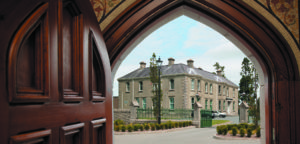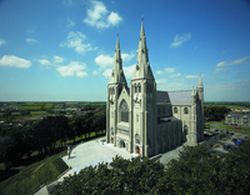ADDRESS GIVEN BY
MOST REVEREND DR. SEÁN BRADY,
ARCHBISHOP OF ARMAGH AND PRIMATE OF ALL-IRELAND
TO THE
IRISH ASSOCIATION SOCIAL CLUB,
SATURDAY, 31ST JANUARY 2004,
IN THE JARVIS PICCADILLY HOTEL, MANCHESTER
Your Excellency, Ambassador Ó Ceallaigh, distinguished guests and friends of the Irish Association Social Club in Manchester, I am particularly pleased to be able to celebrate with you tonight on this the occasion of your Association’s 48th Annual Dinner. Thank you for your warm reception and generous words of welcome.
When any of our emigrant communities meet, it is an opportunity for us to remember those who have journeyed ahead of us. In the mid nineteen fifties, very large numbers of young Irish men and women emigrated from Ireland to England. Very few of them had either work or lodgings awaiting them. The Irish community, which had settled in Manchester in tougher times in the nineteen thirties, was very concerned about the welfare of these young Irish immigrants. They wanted to help them avoid some of the pitfalls, which they themselves had encountered.
It takes enormous courage to leave home and loved ones and begin an adventure in a foreign land, filled with uncertainty, risk and hardship. Today, when global communications can inform one part of the world about what is happening in another in a matter of seconds, it is relatively easy to know what to expect in the country to which one intends to emigrate. In the fifties, such knowledge was not available. The support, therefore, that the settled Irish community gave to the newcomers was absolutely necessary and extremely valuable and helpful.
I congratulate you on your work in this regard down through the years. Long may you continue to watch for and reach out to the stranger among you.
Manchester today is a wonderful city with many Irish connections. For many in Ireland, Manchester is “Manchester United” and the team’s popularity is truly astounding. Their supporters cross all divides in Ireland – North and South. This is largely due to the many Irish born heroes that played, and still play, at Old Trafford. According to the Manchester United Supporters website, seven out of every ten young people in Ireland support ‘The Red Devils’. One has only to think of names like: Kevin Moran, Denis Irwin, Johnny Giles Roy Keane and John O’Shea – to name but a few – to see why this is so.
Manchester also hosts the largest Irish Music Festival in the U.K. I am not surprised that Manchester calls itself the ‘Rock and Goal’ capital of the world!!
Of course there are many famous Irish names associated with football and music. We have every reason to be proud of them. However, they should not distract from the tens of thousands of Irish who also influence the heart and soul of life in this city today. There are many unsung heroes who make gallant efforts to improve the quality of life of this city by their involvement in parish organisations, clubs and societies, and many other of this city’s sporting and cultural bodies. Long may you continue to enrich the associations and societies you so generously serve.
Many second generation Irish are happily integrated into the life of Manchester and Britain generally. Many of you Irish born parents are proud as you look at how your children have achieved so much. It happened because you took the risk of making your home here. Many of you, as migrants, were motivated not by your own interest solely but you also thought of the opportunities that this land could offer to your children.
As the Irish have enriched Manchester, over the past two centuries, the Irish community here have also been a source of enrichment for the mother country. On a basic level, it was money sent back from the Irish in Britain which kept many an Irish farm and family afloat during harsher times back home. More recently, many Irish have returned from cities such as Manchester with new skills and experiences gained here which they, in turn, have used to reinvigorate Ireland. Indeed the returning Irish are some of the unsung heroes of Ireland’s recent economic boom.
Since 1957, the Irish Bishops have endeavoured to serve the needs of emigrants. Over the years, we have tried, to the best of our ability, to serve you and where possible send Migrant Chaplains who are dedicated to your care. Sadly, with a shortage of priests back home, we will have to carefully examine how we can sustain this into the future.
Here, I would like to pay tribute not just to our Migrant Chaplains but to the many Irish born who came here and ministered to your needs in many and varied ways. I would like also to pay tribute to the many amongst the English clergy who understand the distinct cultural needs of the Irish as you practice your faith in this land. Their understanding is very important.
The Irish Bishops’ Conference recently welcomed the findings of the Report entitled, ‘Ireland and the Irish Abroad’, given to the Minister for Foreign Affairs, Mr Brian Cowen TD. I ask the Irish Ambassador to pass on our appreciation to Minister Cowen for his enthusiasm for and commitment to this project. Bishop Seamus Hegarty of Derry, who is Chairman of the Irish Bishops’ Commission for Emigrants, a few weeks ago, called on the Minister to implement the Report’s recommendations.
This was in light of an R.T.É Irish television programme (Prime Time). That programme highlighted the plight of a number of Irish people who have fallen on hard times. What makes their predicament so heartfelt is that they gave so much to our country in leaner days. In many cases they left Ireland out of absolute necessity. When they went abroad, they continued to remember their families and friends at home and regularly sent money back to their loved ones. The ‘Prime Time’ television programme revealed their sad circumstances and highlighted the urgent need for the implementation of the nineteen recommendations contained within the ‘Ireland and Irish Abroad’ Report.
The Bishops’ Conference in Ireland fully supports Bishop Hegarty’s call to Government as a matter of priority to establish an “Agency for the Irish abroad” as recommended by the Task Force set up to co-ordinate services at home and abroad for our Diaspora.
The Task Force report is strong in its support for a holistic approach to the care and nurturing not just of the Irish abroad but of Ireland abroad. The efforts of the Irish abroad to promote their culture should be supported and guided as we journey into a Europe where cultural and ethnic identity are essential to a truly balanced and integrated Europe.
With this in mind, some Irish dioceses, this year, are participating in a Saint Patrick’s Day initiative entitled Supporting Irish Abroad .The aim of this initiative is to remember the Irish abroad in a constructive way. To create awareness is important but more is needed. We promise to use whatever resources we can to continue to campaign on your behalf.
In 1985 the Irish Bishops’ Commission for Emigrants identified and highlighted the needs of Irish prisoners and set up the Irish Commission for Prisoners Overseas (ICPO). This body is entrusted with the care of prisoners and their families. There is one major and long-standing difficulty in this area that causes us particular concern. Under the European Convention on the Treaty of Sentenced Persons Act (1984) foreign nationals, in prison, are entitled to apply for repatriation to the country of their birth to serve their sentences closer to their families. The Irish Bishops’ Commission for Prisoners Overseas, which has offices in Maynooth and London has been assisting with the repatriation of Irish nationals from prisons in the UK for many years. It has long been concerned about the inordinate delay in the processing of such applications.
According to records, it takes between 2½ to 3 years to process a straight forward UK to Republic of Ireland application. This is entirely unsatisfactory. We are dealing with two legal jurisdictions which share a common language. This time scale compares unfavourably with that for British Nationals where the process of repatriation from all countries (including non-English speaking countries), takes between 9 to 12 months to complete. It is little short of a scandal that Irish families should find themselves in this situation. This is an example of the need that exists for an Agency for the Irish Abroad that will co-ordinate the necessary Departments and Agencies to ensure that the emigrant in prison does not suffer unnecessarily. In this “International Year of the Family”, our governments should make every effort to reduce the burdens on prisoners’ families. It is obvious that if society facilitates close links between a prisoner and his or her family’s support and influence, then it greatly reduces the risk of re-offence and also reduces the likelihood of homelessness after release from prison.
Movement of peoples on a global scale is a reality today. We take for granted, for the most part, that capital, goods and information, but not people, move freely and quickly across borders. In today’s world all categories of migrants are experiencing increasingly restrictive policies and procedures.
Over the centuries, we have learned a great deal as an emigrant people. The task now is to remember that experience. Of course we should acknowledge the pain and the sorrow but without forgetting the opportunities and blessing which this experience contains. We should reflect on the lessons that reside within our collective emigrant experience and learn from them. Ireland, as current holder of the EU Presidency, should make reference to the story of our people in contributing to the debate about the appropriate policies and legislation that the EU needs to put in place vis-à-vis the movement of peoples. In its term of Presidency of the European Union, Ireland has a duty to lead public opinion and debate on this emotive issue and not fall victim to scaremongering and myths. The objective of our Presidency should be to provide the most enlightened legislation and to avoid the creation of a ‘fortress Europe’ mentality.
There are legitimate measures which countries must take to control borders, and the movement of people. However, there is a great danger in the post Sept 11th world that an ever-increasing range of security measures, some of which may breach human rights, become acceptable and, in addition, fuel ungrounded fears.
Research shows how much the EU is, and will increasingly become, dependent on migrant labour. The EU has a decreasing and ageing population. Even where there is unemployment there will always be the 3 “d”s – difficult, dirty and dangerous work, which will largely be carried out by immigrants.
As the Irish once enriched Manchester, so can new global immigrants enrich Europe. To quote remarks made earlier this week by the Secretary General of the United Nations, Mr. Kofi Annan: a closed Europe will be “a meaner, poorer, weaker, older” one. An open one will be “fairer, richer, stronger, younger – provided Europe manages immigration well”. In making these points, he argued that immigrants are “part of the solution, not part of the problem”. They must not be made a scapegoat for “a vast array of social ills” as they adjust to their new societies.
Ireland’s Presidency of the European Union should be an opportunity to take the lead in assuring that the European Union’s approach to asylum seekers in particular and migrants in general will be marked by a humanitarian approach, which upholds the dignity of each person and respects their human rights through policies that are fair, just and transparent . Our EU Presidential leadership should be marked by our experience of being for centuries a migrant people – people, on the one hand forced abroad to seek a living and, on the other, people who chose to go abroad to tell others about the goodness of God and about the coming amongst us of Christ … THE STRANGER. In the words of His Holiness, Pope John Paul, “How can we say we welcome Christ if we close the door to the stranger in our midst?”
The arrival of the stranger in our midst calls us to embrace a new and more authentic vision of Church. To be Catholic and universal in the truest sense….calls us in the words of Isaiah ‘to widen the space of our tent'(Is.54:2), to be part of the Reign of God which gathers together people from every tribe, language, nation and race'(Rev. 5:9), where all are children of God and ‘there can be neither Jew nor Greek, ..slave or free person….male or female… (Gal. 3: 27, 28).
The presence among us of people from a variety of cultural and religious backgrounds is a gift for us in that it enables us to broaden our experience of Church, to see that God calls all of humankind into one family and to realise that the earth is given for all. God’s map does not have the same boundaries that our map has.
Speaking of maps and boundaries, I am reminded of home and of a different but equally important topic. In Northern Ireland, the political pace is set to quicken when the formal Review of the implementation of the Good Friday Agreement commences on Tuesday next, in Belfast, under the co-chairmanship of the British and Irish Governments. I wish all the parties well in their deliberations. Last Thursday evening’s cordial and constructive face-to-face meeting between Dr. Ian Paisley, leader of the Democratic Unionist Party, and the Taoiseach, Mr. Bertie Ahern, and their respective delegations, at the Irish Embassy in London, augurs well for the upcoming Review. I hope and pray that the Review will take account of all the participants’ viewpoints and difficulties and will see an end to all forms of paramilitarism and will, in turn, accommodate the re-establishment of a truly inclusive and robust Northern Ireland Executive that is both just and stable and committed to peace building and the development of good relations between all of the people of these islands, irrespective of political persuasion, creed, class or colour.
Finally, I would like to leave you tonight with the prayer of the Breton fisherman: “Dear God, be good to me, the sea is so wide and my boat is so small”.



You must be logged in to post a comment.